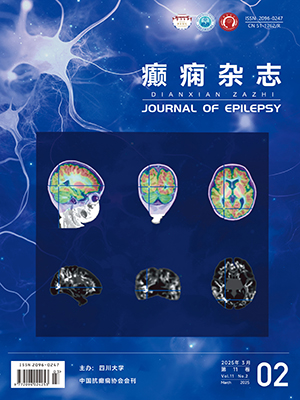| 1. |
Ding D, Wang W, Wu J, et al. Premature mortality in people with epilepsy in rural China:a prospective study. Lancet neurology, 2006, 5(10):823-827.
|
| 2. |
Zhu DT, Jin LJ, Xie GJ, et al. Quality of life and personality in adults with epilepsy. Epilepsia, 1998, 39(11):1208-1212.
|
| 3. |
Ficker DM, So EL, Shen WK, et al. Population-based study of the incidence of sudden unexplained death in epilepsy. Neurology, 1998, 51(5):1270-1274.
|
| 4. |
Shorvon S, Tomson T. Sudden unexpected death in epilepsy. The Lancet, 2011, 378(9808):2028-2038.
|
| 5. |
Hesdorffer DC, Tomson T, Benn E, et al. Combined analysis of risk factors for SUDEP. Epilepsia, 2011, 52(6):1150-1159.
|
| 6. |
Monte CP, Arends JB, Tan IY, et al. Sudden unexpected death in epilepsy patients:Risk factors. A systematic review. Seizure, 2007, 16(1):1-7.
|
| 7. |
Jehi L, Najm IM. Sudden unexpected death in epilepsy:impact, mechanisms, and prevention. Cleveland Clinic Journal of Medicine, 2008, 75(Suppl 2):66.
|
| 8. |
Devinsky O. Sudden, unexpected death in epilepsy. New England Journal of Medicine, 2011, 365(19):1801-1811.
|
| 9. |
Mu J, Liu L, Zhang Q, et al. Causes of death among people with convulsive epilepsy in rural West China:a prospective study. Neurology, 2011, 77(2):132-137.
|
| 10. |
Biswal B, Yetkin FZ, Haughton VM. Functional connectivity in the motor cortex of resting human brain using echo-planar MRI. Magnetic resonance in medicine:official journal of the Society of Magnetic Resonance in Medicine/Society of Magnetic Resonance in Medicine, 1995, 34(4):537-541.
|
| 11. |
Karabanov A, Blom O, Forsman L. The dorsal auditory pathway is involved in performance of both visual and auditory rhythms. Neuro Image, 2009, 44(2):480-488.
|
| 12. |
Beckmann CF, DeLuca M, Devlin JT. Investigations into resting-state connectivity using independent component analysis. Philosophical Transactions of the Royal Society B:Biological Sciences, 2005, 360(1457):1001-1013.
|
| 13. |
Mantini D, Perrucci MG, Del Gratta C. Electrophysiological signatures of resting state networks in the human brain. Proceedings of the National Academy of Sciences, 2007, 104(32):13170-13175.
|
| 14. |
Engel J. A proposed diagnostic scheme for people with epileptic seizures and with epilepsy:report of the ILAE Task Force on Classification and Terminology. Epilepsia, 2001, 42(6):796-803.
|
| 15. |
Wandschneider B, Koepp M, Scott C, et al. Structural imaging biomarkers of sudden unexpected death in epilepsy. Brain, 2015, 138(10):2907-2919.
|
| 16. |
Tang Y, Chen Q, Yu X, et al. A resting-state functional connectivity study in patients at high risk for sudden unexpected death in epilepsy. Epilepsy & Behavior, 2014, 41(7):33-38.
|
| 17. |
Norden AD, Blumenfeld H. The role of subcortical structures in human epilepsy. Epilepsy & Behavior, 2002, 3(3):219-231.
|
| 18. |
Blumenfeld H, Varghese G, Purcaro M, et al. Cortical and subcortical networks in human secondarily generalized tonic-clonic seizures. Brain, 2009, 132(4):999-1012.
|
| 19. |
Nashef L, Walker F, Allen P. Apnoea and bradycardia during epileptic seizures:relation to sudden death in epilepsy. Journal of Neurology, Neurosurgery & Psychiatry, 1996, 60(3):297-300.
|
| 20. |
Lotufo PA, Valiengo L, Benseñor IM. A systematic review and meta-analysis of heart rate variability in epilepsy and antiepileptic drugs. Epilepsia, 2012, 53(2):272-282.
|
| 21. |
Hermann BP, Seidenberg M, Bell B. The neurodevelopmental impact of childhood onset temporal lobe epilepsy on brain structure and function and the risk of progressive cognitive effects. Progress in Brain Research, 2002, 135(5):429-438.
|
| 22. |
Leung H, Kwan P, Elger C. Finding the missing link between ictal bradyarrhythmia, ictal asystole, and sudden unexpected death in epilepsy. Epilepsy & Behavior, 2006, 9(1):19-30.
|
| 23. |
Lado FA, Moshé SL. How do seizures stop?. Epilepsia, 2008, 49(10):1651-1664.
|
| 24. |
Bonilha L, Rorden C, Castellano G. Voxel-based morphometry of the thalamus in patients with refractory medial temporal lobe epilepsy. NeuroImage, 2005, 25(3):1016-1021.
|
| 25. |
Neubauer JA, Sunderram J. Oxygen-sensing neurons in the central nervous system. Journal of Applied Physiology, 2004, 96(1):367-374.
|
| 26. |
Gellhorn E, Ballin H, Riggle C. Hypothalamus and thalamus as pacemakers of cortical activity in asphyxia and anoxia. Journal of Neural Transmission, 1951, 2(3):237-262.
|
| 27. |
Pattinson KT, Mitsis GD, Harvey AK, et al. Determination of the human brainstem respiratory control network and its cortical connections in vivo using functional and structural imaging. NeuroImage, 2009, 44(2):295-305.
|
| 28. |
Delgado J. Circulatory effects of cortical stimulation. Physiological Reviews, 1960, 4(1):146.
|
| 29. |
Boyko WJ, Kek Galabru C, Mc Geer EG, et al. Thalamic injections of kainic acid produce myocardial necrosis. Life Sciences, 1979, 25(1):87-97.
|
| 30. |
Scorza FA, Sander JW, Cendes F, et al. A possible role of the thalamus in some cases of sudden unexpected death in epilepsy. Epilepsia, 2007, 48(5):1036-1037.
|
| 31. |
Kumar R, Woo MS, Macey PM, et al. Progressive gray matter changes in patients with congenital central hypoventilation syndrome. Pediatric Research, 2012, 71(6):701-706.
|
| 32. |
Leung H, Schindler K, Kwan P, et al. Asystole induced by electrical stimulation of the left cingulate gyrus. Epileptic Disorders, 2007, 9(1):77.
|
| 33. |
Woodward SH, Kaloupek DG, Schaer M, et al. Right anterior cingulate cortical volume covaries with respiratory sinus arrhythmia magnitude in combat veterans. J Rehabil Res Dev, 2008, 45(2):451-463.
|
| 34. |
Devinsky O, Pacia S, Tatambhotla G. Bradycardia and asystole induced by partial seizures a case report and literature review. Neurology, 1997, 48(6):1712-1714.
|
| 35. |
Mc Lean BN, Wimalaratna S. Sudden death in epilepsy recorded in ambulatory EEG. Journal of Neurology Neurosurgery and Psychiatry, 2007, 78(12):1395-1397.
|
| 36. |
Lhatoo SD, Faulkner HJ, Dembny K, et al. An electroclinical case-control study of sudden unexpected death in epilepsy. Annals of Neurology, 2010, 68(6):787-796.
|
| 37. |
Lee HW, Hong SB, Tae WS, et al. Partial seizures manifesting as apnea only in an adult. Epilepsia, 1999, 40(12):1828-1831.
|
| 38. |
Thom M, Seetah S, Sisodiya S, et al. Sudden and unexpected death in epilepsy (SUDEP):evidence of acute neuronal injury using HSP-70 and c-JUN immunohistochemistry. Neuropathology and Applied Neurobiology, 2003, 29(2):132-143.
|




